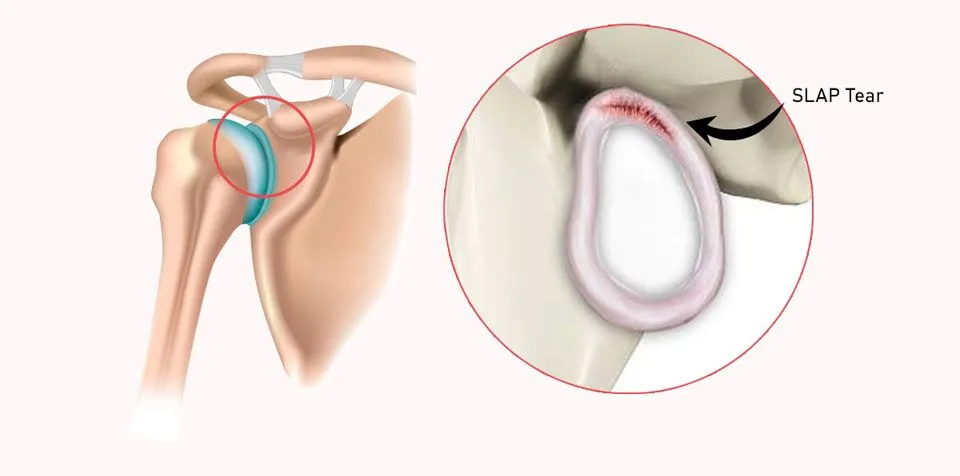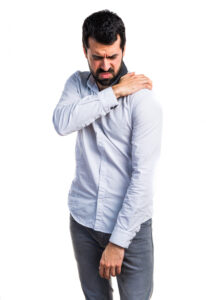Overview
What is a SLAP Tear?
Superior Labrum Anterior and Posterior is referred to as SLAP tears. The top (superior) portion of the labrum is hurt in SLAP injuries. The biceps tendon joins the labrum in this top region as well. Superior Labrum Anterior and Posterior Tear can affect both the front and back surfaces of this attachment point, potentially involving the biceps tendon as well.
As a result of repeated shoulder motion, those who engage in repetitive overhead sports, such as throwers or weightlifters, may develop labrum tears.
However, a lot of tears are brought on by the labrum’s gradual degeneration over time. The superior labrum’s tearing or fraying can be recognized as a typical ageing process in people who are older than 30 to 40 years old. This differs from an acute injury in a younger individual.

What are the consequences of leaving untreated tear?
If not addressed, symptoms of a SLAP tear may exacerbate, leading to persistent shoulder discomfort and reduced arm and shoulder mobility over time.
What is the typical duration of recovery from a SLAP tear?
Recovery from a tear typically ranges from six months to a year.
Causes & Symptoms of a Superior Labrum Anterior and Posterior Tear
Causes
SLAP lesion can arise from various causes, including falling onto an outstretched hand, lifting heavy objects abruptly, or engaging in forceful overhead arm movements during sports or work activities. However, they often stem from prolonged shoulder stress, gradually wearing down the shoulder labrum over time.
Individuals whose daily routines involve frequent upward arm movements, such as weightlifters, tennis players, and certain manual laborers, are particularly prone to SLAP lesion.
Moreover, this tears can be associated with or triggered by conditions like biceps tendonitis or a tear in the biceps tendon. In cases where the biceps tendon tears away from its attachment point on the scapula bone (shoulder blade), it can also damage the glenoid labrum.
Symptoms
Superior Labrum Anterior and Posterior Tear can induce discomfort and limitations in the shoulder labrum, the biceps tendon, or both. Typical symptoms encompass:
- Persistent or throbbing shoulder pain, particularly when lifting overhead
- Unpleasant sensations of clicking, popping, or grinding in the shoulder during motion
- Challenges in executing regular shoulder movements
- Discomfort located at the front of the shoulder near the biceps tendon
- Restricted range of motion
Diagnosis of Superior Labrum Anterior and Posterior Tear
SLAP tears are diagnosed through two primary methods:
1. Physical assessment.
2. MRI (Magnetic Resonance Imaging).
Who requires treatment for a SLAP lesion?
Healthcare providers assess several factors to determine whether Superior Labrum Anterior and Posterior Tear surgery is required:
- Classification of the tear, which considers its location and impact on other shoulder areas.
- Age of the patient.
- Patient’s usual activities.
- History of prior non-surgical treatments.
Types of Superior Labrum Anterior and Posterior Tear
- Type I SLAP Tear
- Degenerative Fraying occurs at the edge of the labrum.
- The attachment to the upper part of the glenoid remains intact.
- Type II SLAP Tear
- Typically occurs suddenly.
- Both the labrum and the long head of the biceps tendon (LHBT) tear and detach from the glenoid socket.
- The area where it detaches lacks cartilage due to the injury.
- Type III SLAP Tear
- Displays a “bucket-handle” pattern.
- The attachment of the labrum to the LHBT remains unaffected.
- This type is the least common.
- Type IV SLAP Tear
- Described as “Type III with anterior shoulder instability.”
- It involves the Type III tear pattern along with extension into the LHBT.
- Often observed alongside shoulder instability and anterior labral tears.
Read more Types of Superior Labrum Anterior and Posterior Tear.
Management & Treatment of the Tear
SLAP Treatment
The treatment for SLAP tears is determined by the extent and type of damage identified during labrum examination by healthcare providers. They may initially suggest non-surgical approaches before considering surgery. However, complete healing of Superior Labrum Anterior and Posterior Tear often takes several months. Common treatment options include:
- Rest.
- Anti-inflammatory medication.
- Cortisone injections.
- Physical therapy.
- Debridement.
- Arthroscopic labral surgery for labrum repair.
- Biceps tenodesis.
Post SLAP lesion surgery, the following typically occurs:
- You’ll wear an arm sling to avoid putting weight on the injured shoulder, possibly for several weeks to months.
- Your shoulder may feel stiff and weak.
- Your ability to move your shoulder may remain restricted.
- Your doctor may advise light exercises or physical therapy to aid in strength recovery.
Prevention
While some SLAP tears may be inevitable, such as when attempting to break a fall with an outstretched arm, others can result from repetitive overhead arm movements in activities like sports or lifting objects with sudden, jerking motions.
Here are steps you can take to prevent a SLAP lesion:
- Warm up your shoulder muscles with stretching exercises before engaging in sports activities.
- Be attentive to any changes in your shoulder sensations, such as pain or stiffness, and consult your healthcare provider if you notice any.
How long does it take to recover post Superior Labrum Anterior and Posterior Tear surgery?
Although the surgery is usually performed arthroscopically on an outpatient basis (allowing patients to return home the same day), the recovery process is challenging. Patients typically wear a sling for six weeks, after which they engage in more intensive physical therapy to focus on stretching and strengthening. Athletes usually begin gradually returning to sports around four months post-surgery, with complete, unrestricted participation achieved on average by six months.
